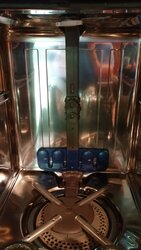I have a Kitchenaid dishwasher that the bottom half works, but no water pressure is going up the tube to the upper rack to clean the dishes on the upper rack. Annoying, I just fixed the upper rack the other day.
Has anyone encountered this before? Here is the pump diagram.... Kitchenaid Model KUDS301XBL1
http://www.partselect.com/ModelSect...sition=9&mfg=Whirlpool&Type=Dishwasher&Mark=9
Thought it might be a pump but I think it has only one. Check valve?
I took the upper rack off and am only using the bottom...
Has anyone encountered this before? Here is the pump diagram.... Kitchenaid Model KUDS301XBL1
http://www.partselect.com/ModelSect...sition=9&mfg=Whirlpool&Type=Dishwasher&Mark=9
Thought it might be a pump but I think it has only one. Check valve?
I took the upper rack off and am only using the bottom...


